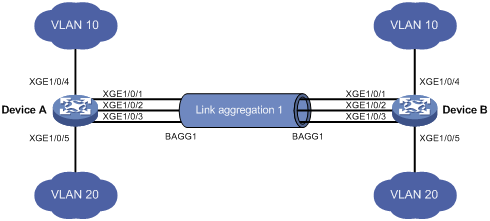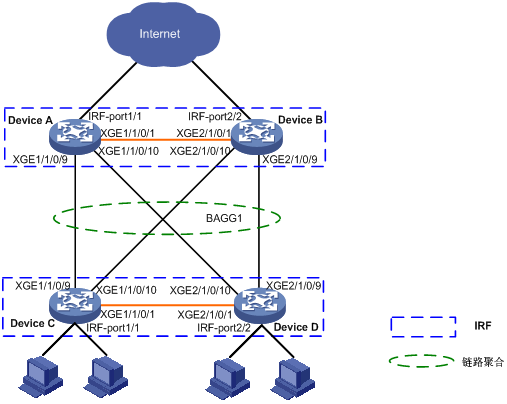02-H3C_S12500-S_以太网链路聚合典型配置举例
本章节下载: 02-H3C_S12500-S_以太网链路聚合典型配置举例 (236.73 KB)
H3C S12500-S以太网链路聚合典型配置举例
|
Copyright © 2015 杭州华三通信技术有限公司 版权所有,保留一切权利。 非经本公司书面许可,任何单位和个人不得擅自摘抄、复制本文档内容的部分或全部, 并不得以任何形式传播。本文档中的信息可能变动,恕不另行通知。 |
|
目 录
本文档介绍以太网链路聚合特性的配置举例。
本文档中的配置均是在实验室环境下进行的配置和验证,配置前设备的所有参数均采用出厂时的缺省配置。如果您已经对设备进行了配置,为了保证配置效果,请确认现有配置和以下举例中的配置不冲突。
本文档假设您已了解以太网链路聚合特性。
如图1所示,Device A和Device B通过以太网链路连接VLAN 10、VLAN 20的用户网络。由于Device A和Device B之间有较大数据流量,要求通过配置二层链路聚合组,实现:
· Device A和Device B之间提供较大的链路带宽来使相同VLAN内的用户互相通信。
· 捆绑一起的链路形成相互动态备份,提高数据传输的可靠性。

要使VLAN 10与VLAN 20的数据流量均能通过二层聚合接口1,可配置二层聚合接口的链路类型为Trunk,并允许VLAN 10和VLAN 20的报文通过。
本举例是在S12500-S-CMW710-R7150P02版本上进行配置和验证的。
· 配置聚合组的成员端口过程中,建议配置顺序:在端口视图下使用display this命令查看端口上是否存在属性类配置(包括端口隔离配置、QinQ配置、VLAN配置、VLAN映射),如果有这类配置,请使用对应的undo命令删除这些配置,使端口保持在缺省属性类配置状态,然后再把端口加入到新创建的聚合组内。
· 链路聚合分为静态聚合和动态聚合两种模式,用户可根据这两种模式的特点,结合具体组网情况选择其中一种进行配置。
¡ 静态聚合组在完成配置后,端口的选中/非选中状态不受网络环境的影响,比较稳定,但不能根据对端的状态调整成员端口的选中/非选中状态。
¡ 动态聚合组能够根据对端和本端的信息调整端口的选中/非选中状态,比较灵活,但其成员端口的选中/非选中状态容易受网络环境的影响。
· 配置或使能了下列功能的端口将不能加入二层聚合组:MAC地址认证、端口安全模式、802.1X功能。
# 创建VLAN 10,并将端口Ten-GigabitEthernet1/0/4加入到该VLAN 10中。
<DeviceA> system-view
[DeviceA] vlan 10
[DeviceA-vlan10] port ten-gigabitethernet 1/0/4
[DeviceA-vlan10] quit
# 创建VLAN 20,并将端口Ten-GigabitEthernet1/0/5加入到该VLAN 20中。
[DeviceA] vlan 20
[DeviceA-vlan20] port ten-gigabitethernet 1/0/5
[DeviceA-vlan20] quit
# 创建二层聚合接口1。(根据具体情况选择下面两种方式之一)
· 采用静态聚合模式:创建二层聚合接口1
[DeviceA] interface bridge-aggregation 1
[DeviceA-Bridge-Aggregation1] quit
· 采用动态聚合模式:创建二层聚合接口1,并配置动态聚合模式
[DeviceA] interface bridge-aggregation 1
[DeviceA-Bridge-Aggregation1] link-aggregation mode dynamic
[DeviceA-Bridge-Aggregation1] quit
# 分别将端口Ten-GigabitEthernet1/0/1~Ten-GigabitEthernet1/0/3加入到聚合组1中。
[DeviceA] interface ten-gigabitethernet 1/0/1
[DeviceA-Ten-GigabitEthernet1/0/1] port link-aggregation group 1
[DeviceA-Ten-GigabitEthernet1/0/1] quit
[DeviceA] interface ten-gigabitethernet 1/0/2
[DeviceA-Ten-GigabitEthernet1/0/2] port link-aggregation group 1
[DeviceA-Ten-GigabitEthernet1/0/2] quit
[DeviceA] interface ten-gigabitethernet 1/0/3
[DeviceA-Ten-GigabitEthernet1/0/3] port link-aggregation group 1
[DeviceA-Ten-GigabitEthernet1/0/3] quit
# 配置二层聚合接口1为Trunk端口,并允许VLAN 10和VLAN 20的报文通过。
[DeviceA] interface bridge-aggregation 1
[DeviceA-Bridge-Aggregation1] port link-type trunk
Configuring Ten-GigabitEthernet1/0/1 done.
Configuring Ten-GigabitEthernet1/0/2 done.
Configuring Ten-GigabitEthernet1/0/3 done.
[DeviceA-Bridge-Aggregation1] port trunk permit vlan 10 20
Configuring Ten-GigabitEthernet1/0/1 done.
Configuring Ten-GigabitEthernet1/0/2 done.
Configuring Ten-GigabitEthernet1/0/3 done.
[DeviceA-Bridge-Aggregation1] quit
Device B上的配置与Device A完全相同,此处不再赘述。
# 通过display link-aggregation verbose命令来显示聚合组的相关信息,以验证配置是否成功。
· 采用静态聚合模式的链路聚合配置信息
[DeviceA] display link-aggregation verbose
Loadsharing Type: Shar -- Loadsharing, NonS -- Non-Loadsharing
Port Status: S -- Selected, U -- Unselected, I -- Individual
Flags: A -- LACP_Activity, B -- LACP_Timeout, C -- Aggregation,
D -- Synchronization, E -- Collecting, F -- Distributing,
G -- Defaulted, H -- Expired
Aggregation Interface: Bridge-Aggregation1
Aggregation Mode: Static
Loadsharing Type: Shar
Port Status Priority Oper-Key
--------------------------------------------------------------------------------
XGE1/0/1 S 32768 1
XGE1/0/2 S 32768 1
XGE1/0/3 S 32768 1
结果说明:本端加入到静态聚合组内的成员端口都处于Selected状态,与对端对应端口是否是Selected状态无关。
· 采用动态聚合模式的链路聚合配置信息
[DeviceA] display link-aggregation verbose
Loadsharing Type: Shar -- Loadsharing, NonS -- Non-Loadsharing
Port Status: S -- Selected, U -- Unselected, I -- Individual
Flags: A -- LACP_Activity, B -- LACP_Timeout, C -- Aggregation,
D -- Synchronization, E -- Collecting, F -- Distributing,
G -- Defaulted, H -- Expired
Aggregation Interface: Bridge-Aggregation11
Aggregation Mode: Dynamic
Loadsharing Type: Shar
System ID: 0x8000, 000f-e234-5678
Local:
Port Status Priority Oper-Key Flag
--------------------------------------------------------------------------------
XGE1/0/1 S 32768 1 {ACDEF}
XGE1/0/2 S 32768 1 {ACDEF}
XGE1/0/3 S 32768 1 {ACDEF}
Remote:
Actor Partner Priority Oper-Key SystemID Flag
--------------------------------------------------------------------------------
XGE1/0/1 14 32768 1 0x8000, 0000-fc00-7506 {ACDEF}
XGE1/0/2 15 32768 1 0x8000, 0000-fc00-7506 {ACDEF}
XGE1/0/3 16 32768 1 0x8000, 0000-fc00-7506 {ACDEF}
结果说明:本端和对端设备上聚合组内的成员端口都处于Selected状态。原因是在动态链路聚合中通过LACP协议报文交互,可使两端聚合组内的成员端口选中状态达成一致,可顺利实现对用户数据的转发。
· Device A:
#
vlan 10
#
interface Ten-GigabitEthernet1/0/4
port link-mode bridge
port access vlan 10
#
vlan 20
#
interface Ten-GigabitEthernet1/0/5
port link-mode bridge
port access vlan 20
¡ 采用静态聚合模式
#
interface Bridge-Aggregation1
port link-type trunk
port trunk permit vlan 10 20
¡ 采用动态聚合模式
#
interface Bridge-Aggregation1
port link-type trunk
port trunk permit vlan 10 20
link-aggregation mode dynamic
#
interface Ten-GigabitEthernet1/0/1
port link-mode bridge
port link-type trunk
port trunk permit vlan 10 20
port link-aggregation group 1
#
interface Ten-GigabitEthernet1/0/2
port link-mode bridge
port link-type trunk
port trunk permit vlan 10 20
port link-aggregation group 1
#
interface Ten-GigabitEthernet1/0/3
port link-mode bridge
port link-type trunk
port trunk permit vlan 10 20
port link-aggregation group 1
#
· Device B:
Device B上的配置文件与Device A相同。
如图2所示,接入层和汇聚层都有两台设备,现要求使用链路聚合特性和IRF特性实现以下需求:
· 由于公司人员不断增加,要求接入层具有易管理能力和强扩展能力,可以提供更多的端口来满足PC的接入需求。
· 由于接入层的流量增加,要求增强接入层到汇聚层的链路具有较高可靠性,且可实现流量的负载分担。
图2 以太网链路聚合配置IRF配置组网图

· 要使接入层具有易管理能力和强扩展能力,可通过配置IRF功能,轻松扩展接入层端口数量、带宽。
· 为了提高链路可靠性,可通过配置链路聚合配合IRF功能实现,每台接入层设备双上行连到汇聚层上,并且将四条上行链路进行聚合,当某个成员设备离开IRF,其它成员设备上的链路仍能收发报文,从而提高了链路的可靠性。
· 可以通过配置链路聚合的负载分担功能以实现流量均衡转发。
· 可以在汇聚层IRF和接入层IRF上同时开启LACP MAD功能,使两个IRF相互作为中间设备,完成各自的LACP MAD检测。以快速排查IRF分裂原因并及时恢复成员设备IRF状态。
本举例是在S12500-S-CMW710-R7150P02版本上进行配置和验证的。
· IRF物理端口必须工作在二层模式下,才能与IRF端口进行绑定。
· 与同一个IRF端口绑定的多个IRF物理端口必须工作在相同模式。
· IRF中成员设备间相连的IRF物理端口必须配置为同一种工作模式。关于配置IRF物理端口的工作模式的介绍,请参见“虚拟化配置指导”中的“IRF”。
· 配置聚合组的成员端口过程中,建议配置顺序:在端口视图下使用display this命令查看端口上是否存在属性类配置(包括端口隔离配置、QinQ配置、VLAN配置、VLAN映射),如果有这类配置,请使用对应的undo命令删除这些配置,使端口保持在缺省属性类配置状态,然后再把端口加入到新创建的聚合组内。
· 由于静态聚合组中成员端口选中状态不受对端端口是否在聚合组中及是否处于选中状态的影响。这样有可能导致两端设备所确定的Selected状态端口不一致,并且LACP MAD必须在动态聚合接口上应用才能生效。所以本例要求用户选择配置动态聚合组。
· 配置或使能了下列功能的端口将不能加入二层聚合组:MAC地址认证、端口安全模式、802.1X功能。
(1) Device A的IRF相关配置
#将Device A的成员编号配置为1。
[DeviceA] irf member 1
#创建IRF端口为1,并将它与物理端口Ten-GigabitEthernet1/0/1绑定。
[DeviceA] irf-port 1
[DeviceA-irf-port1] port group interface ten-gigabitethernet 1/0/1
[DeviceA-irf-port1] quit
# 将当前配置保存到下次启动配置文件。
[DeviceA] quit
<DeviceA> save
# 将设备的运行模式切换到IRF模式,并重启设备使新编号生效。
<DeviceA> system-view
[DeviceA] chassis convert mode irf
The device will switch to IRF mode and reboot.
You are recommended to save the current running configuration and specify the configuration file for the next startup. Continue? [Y/N]:y
Do you want to convert the content of the next startup configuration file flash:/startup.cfg to make it available in IRF mode? [Y/N]:y
Please wait...
Saving the converted configuration file to the main board succeeded.
Slot 1:
Saving the converted configuration file succeeded.
Now rebooting, please wait...
设备重启后Device A组成了只有一台成员设备的IRF,并且设备上的以太网接口编号由三维变成四维,例如:Ten-GigabitEthernet1/0/1在重启设备后的接口编号为Ten-GigabitEthernet1/1/0/1。
(2) Device B的IRF相关配置
# 配置Device B的成员编号为2,创建IRF端口2,并将它与物理端口Ten-GigabitEthernet1/0/1绑定。
<DeviceB> system-view
[DeviceB] irf member 2
[Sysname] irf-port 2
[DeviceB-irf-port2] port group interface ten-gigabitethernet 1/0/1
[DeviceB-irf-port2] quit
# 将当前配置保存到下次启动配置文件。
[DeviceB] quit
<DeviceB> save
# 参照4.1 图2进行物理连线。
# 将设备的运行模式切换到IRF模式,并重启设备使新编号生效。
<DeviceB> system-view
[DeviceB] chassis convert mode irf
The device will switch to IRF mode and reboot.
You are recommended to save the current running configuration and specify the configuration file for the next startup. Continue? [Y/N]:y
Do you want to convert the content of the next startup configuration file flash:/startup.cfg to make it available in IRF mode? [Y/N]:y
Please wait...
Saving the converted configuration file to the main board succeeded.
Slot 1:
Saving the converted configuration file succeeded.
Now rebooting, please wait...
设备B重启后与设备A形成IRF,并且设备上的以太网接口编号由三维变成四维,例如:Ten-GigabitEthernet1/0/1在重启设备后的接口编号为Ten-GigabitEthernet2/1/0/1。
# 通过display irf命令来显示IRF相关信息,Device A为Master主设备。
[DeviceA] display irf
MemberID Role Priority CPU-Mac Description
*+1 Master 1 00a0-fc00-5801 ---
2 Standby 1 00e0-fc58-1235 ---
--------------------------------------------------
* indicates the device is the master.
+ indicates the device through which the user logs in.
The Bridge MAC of the IRF is: 00a0-fc00-5800
Auto upgrade : yes
Mac persistent : 6 min
Domain ID : 0
(3) Device A的二层动态聚合组相关配置
# 创建二层动态聚合组1,并配置该接口对应的聚合组按照源IP地址进行聚合负载分担。
[DeviceA] interface bridge-aggregation 1
[DeviceA-Bridge-Aggregation1] link-aggregation mode dynamic
[DeviceA-Bridge-Aggregation1] link-aggregation load-sharing mode source-ip
[DeviceA-Bridge-Aggregation1] quit
# 将Ten-GigabitEthernet1/1/0/9、Ten-GigabitEthernet1/1/0/10、Ten-GigabitEthernet2/1/0/9、Ten-GigabitEthernet2/1/0/10加入该聚合组中。
[DeviceA] interface range ten-gigabitethernet 1/1/0/9 to ten-gigabitethernet 1/1/0/10
ten-gigabitethernet 2/1/0/9 to ten-gigabitethernet 2/1/0/10
[DeviceA-if-range] port link-aggregation group 1
[DeviceA-if-range] quit
[DeviceA]
(4) Device A的LACP MAD相关配置
# 设置IRF域编号为1。
[DeviceA] irf domain 1
# 在动态聚合组1上使能LACP MAD检测功能。
[DeviceA] interface Bridge-Aggregation 1
[DeviceA-Bridge-Aggregation1] mad enable
You need to assign a domain ID (range: 0-4294967295)
[Current domain is: 1]:
The assigned domain ID is: 1
MAD LACP only enable on dynamic aggregation interface.
(5) Device C的IRF相关配置
# Device C上的IRF相关配置与Device A完全相同,此处不再赘述。
(6) Device D的IRF相关配置
# Device D上的IRF相关配置与Device B完全相同,此处不再赘述。
# Device C和Device D间将会进行Master竞选,竞选失败的一方将重启,重启完成后,IRF形成,Device C为Master主设备。
(7) Device C的二层动态聚合组相关配置。
# Device C上的二层动态聚合组相关配置与Device A完全相同,此处不再赘述。
(8) Device C的LACP MAD相关配置
# 设置IRF域编号为2。
<DeviceC> system-view
[DeviceC] irf domain 2
# 在动态聚合组1上使能LACP MAD检测功能。
[DeviceC] interface Bridge-Aggregation 1
[DeviceC-Bridge-Aggregation1] mad enable
You need to assign a domain ID (range: 0-4294967295)
[Current domain is: 2]:
The assigned domain ID is: 2
MAD LACP only enable on dynamic aggregation interface.
# 在Device A上通过display link-aggregation verbose命令来显示聚合组的相关信息,以验证配置是否成功。
[DeviceA] display link-aggregation verbose
Loadsharing Type: Shar -- Loadsharing, NonS -- Non-Loadsharing
Port Status: S -- Selected, U -- Unselected, I -- Individual
Flags: A -- LACP_Activity, B -- LACP_Timeout, C -- Aggregation,
D -- Synchronization, E -- Collecting, F -- Distributing,
G -- Defaulted, H -- Expired
Aggregate Interface: Bridge-Aggregation1
Aggregation Mode: Dynamic
Loadsharing Type: Shar
System ID: 0x8000, 00a0-fc00-5800
Local:
Port Status Priority Oper-Key Flag
--------------------------------------------------------------------------------
XGE1/1/0/9 S 32768 1 {ACDEF}
XGE1/1/0/10 S 32768 1 {ACDEF}
XGE2/1/0/9 S 32768 1 {ACDEF}
XGE2/1/0/10 s 32768 1 {ACDEF}
Remote:
Actor Partner Priority Oper-Key SystemID Flag
--------------------------------------------------------------------------------
XGE1/1/0/9 139 32768 1 0x8000, 0cda-414a-859b {ACDEF}
XGE1/1/0/10 205 32768 1 0x8000, 0cda-414a-859b {ACDEF}
XGE2/1/0/9 204 32768 1 0x8000, 0cda-414a-859b {ACDEF}
XGE2/1/0/10 138 32768 1 0x8000, 0cda-414a-859b {ACDEF}
结果说明:本端和对端设备上聚合组内的成员端口都处于Selected状态。原因是在动态链路聚合中通过LACP协议报文交互,可使两端聚合组内的成员端口选中状态达成一致,可顺利实现对用户数据的转发。
# 显示聚合负载分担类型
[DeviceA] display link-aggregation load-sharing mode interface Bridge-Aggregation 1
Bridge-Aggregation1 Load-Sharing Mode:
source-ip address
结果说明:Bridge-aggregation 1的聚合负载分担方式为根据源IP地址进行负载分担。
# 由于配置了LACP MAD功能,当IRF分裂时,设备会收到相关日志信息,提示IRF分裂原因。
[DeviceA]%Jan 1 03:12:43:397 2011 Transit STM/3/STM_LINK_STATUS_DOWN: IRF port 2 is down.
%Jan 1 03:12:43:410 2011 Transit DEV/3/BOARD_REMOVED: Board is removed from Slo
t 1, type is MAIN_BOARD_TYPE_52QF.
%Jan 1 03:12:44:385 2011 Transit IFNET/3/PHY_UPDOWN: Ten-GigabitEthernet2/1/0/1
link status is down.
%Jan 1 03:12:44:386 2011 Transit IFNET/5/LINK_UPDOWN: Line protocol on the inte
rface Ten-GigabitEthernet2/1/0/1 is down.
结果说明:因为与IRF端口2/2绑定的Ten-GigabitEthernet2/1/0/1物理端口的物理状态为关闭,造成汇聚层IRF分裂。可通过检查物理连线或者线路故障来解决此问题。
· Device A:
#
irf domain 1
irf mac-address persistent timer
irf auto-update enable
irf link-delay 0
irf member 1 priority 1
irf member 2 priority 1
#
irf-port 1/1
port group interface Ten-GigabitEthernet1/1/0/1 mode enhanced
#
irf-port 2/2
port group interface Ten-GigabitEthernet2/1/0/1 mode enhanced
#
interface Bridge-Aggregation1
link-aggregation mode dynamic
link-aggregation load-sharing mode source-ip
#
interface Ten-GigabitEthernet1/1/0/9
port link-mode bridge
port link-aggregation group 1
#
interface Ten-GigabitEthernet1/1/0/10
port link-mode bridge
port link-aggregation group 1
#
interface Ten-GigabitEthernet2/1/0/9
port link-mode bridge
port link-aggregation group 1
#
interface Ten-GigabitEthernet2/1/0/10
port link-mode bridge
port link-aggregation group 1
#
· Device C:
Device C上的配置文件与Device A类似。
如图3所示,Device A与Device B通过以太网链路互连。要求在Device A和Device B上分别配置三层链路聚合组,并为对应的三层聚合接口配置IP地址和子网掩码,从而提高两设备之间的带宽与可靠性。
图3 三层聚合配置示例图

本举例是在S12500-S-CMW710-R7150P02版本上进行配置和验证的。
链路聚合分为静态聚合和动态聚合两种模式,用户可根据这两种模式的特点,结合具体组网情况选择其中一种进行配置。
· 静态聚合组在完成配置后,端口的选中/非选中状态不受网络环境的影响,比较稳定,但不能根据对端的状态调整成员端口的选中/非选中状态。
· 动态聚合组能够根据对端和本端的信息调整端口的选中/非选中状态,比较灵活,但其成员端口的选中/非选中状态容易受网络环境的影响。
# 创建三层聚合接口1。(根据具体情况选择下面两种方式之一)
· 采用静态聚合模式
<DeviceA> system-view
[DeviceA] interface route-aggregation 1
· 采用动态聚合模式
[DeviceA] interface route-aggregation 1
[DeviceA-Route-Aggregation1] link-aggregation mode dynamic
# 为三层聚合接口1配置IP地址和子网掩码。
[DeviceA-Route-Aggregation1] ip address 192.168.1.1 24
[DeviceA-Route-Aggregation1] quit
# 将接口Ten-GigabitEthernet1/0/1~Ten-GigabitEthernet1/0/3加入聚合组1。
[DeviceA] interface range ten-gigabitethernet 1/0/1 to ten-gigabitethernet 1/0/3
[DeviceA-if-range] port link-aggregation group 1
[DeviceA-if-range] quit
Device B上的配置与Device A相同,配置过程略。
# 通过display link-aggregation verbose命令来显示聚合组的相关信息,以验证配置是否成功。
· 采用静态聚合模式的聚合组信息
[DeviceA] display link-aggregation verbose
Loadsharing Type: Shar -- Loadsharing, NonS -- Non-Loadsharing
Port Status: S -- Selected, U -- Unselected
Flags: A -- LACP_Activity, B -- LACP_Timeout, C -- Aggregation,
D -- Synchronization, E -- Collecting, F -- Distributing,
G -- Defaulted, H -- Expired
Aggregate Interface: Route-Aggregation1
Aggregation Mode: Static
Loadsharing Type: Shar
Port Status Priority Oper-Key
--------------------------------------------------------------------------------
XGE1/0/1 S 32768 1
XGE1/0/2 S 32768 1
XGE1/0/3 S 32768 1
结果说明:本端加入到静态聚合组内的成员端口都处于Selected状态,与对端对应端口是否是Selected状态无关。
· 采用动态聚合模式的聚合组信息
[DeviceA] display link-aggregation verbose
Loadsharing Type: Shar -- Loadsharing, NonS -- Non-Loadsharing
Port Status: S -- Selected, U -- Unselected
Flags: A -- LACP_Activity, B -- LACP_Timeout, C -- Aggregation,
D -- Synchronization, E -- Collecting, F -- Distributing,
G -- Defaulted, H -- Expired
Aggregate Interface: Route-Aggregation1
Aggregation Mode: Dynamic
Loadsharing Type: Shar
System ID: 0x8000, 000f-e267-6c6a
Local:
Port Status Priority Oper-Key Flag
--------------------------------------------------------------------------------
XGE1/0/1 S 32768 1 {ACDEF}
XGE1/0/2 S 32768 1 {ACDEF}
XGE1/0/3 S 32768 1 {ACDEF}
Remote:
Actor Partner Priority Oper-Key SystemID Flag
--------------------------------------------------------------------------------
XGE1/0/1 1 32768 1 0x8000, 000f-e267-57ad {ACDEF}
XGE1/0/2 2 32768 1 0x8000, 000f-e267-57ad {ACDEF}
XGE1/0/3 3 32768 1 0x8000, 000f-e267-57ad {ACDEF}
结果说明:本端和对端设备上聚合组内的成员端口都处于Selected状态。原因是在动态链路聚合中通过LACP协议报文交互,可使两端聚合组内的成员端口选中状态达成一致,可顺利实现对用户数据的转发。
· Device A:
#
¡ 采用静态聚合模式
#
interface route-aggregation1
ip address 192.168.1.1 255.255.255.0
#
¡ 采用动态聚合模式
#
interface route-aggregation1
ip address 192.168.1.1 255.255.255.0
link-aggregation mode dynamic
#
interface Ten-GigabitEthernet1/0/1
port link-mode route
port link-aggregation group 1
#
interface Ten-GigabitEthernet1/0/2
port link-mode route
port link-aggregation group 1
#
interface Ten-GigabitEthernet1/0/3
port link-mode route
port link-aggregation group 1
#
· Device B:
Device B上的配置文件与Device A类似。
· H3C S12500-S系列交换机 二层技术-以太网交换配置指导-Release 7150P02
· H3C S12500-S系列交换机 二层技术-以太网交换命令参考-Release 7150P02
不同款型规格的资料略有差异, 详细信息请向具体销售和400咨询。H3C保留在没有任何通知或提示的情况下对资料内容进行修改的权利!
